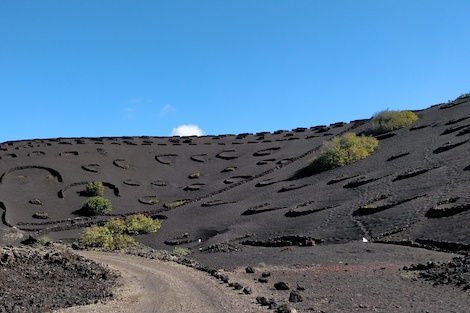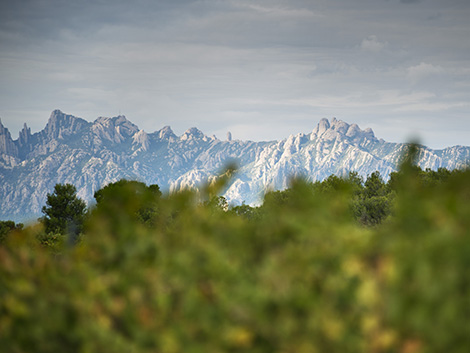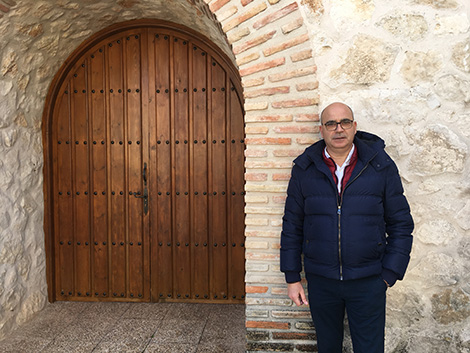Puro Rofe: the new wine frontier in Lanzarote

The story of Puro Rofe is the result of a love affair in the sweltering summer of 2017. After a couple of years working with Niepoort in Portugal and with Raúl Perez in Bierzo and Ribeira Sacra, Carmelo Peña, a young winemaker from Las Palmas, had just returned home with the idea of making his own wine in the island.
During those years, his friend Rayco Fernández, a local wine merchant, had been looking for an artisan-style wine in Lanzarote to include in his Buena Uva catalogue. He did not find it until 24 July of that year, when he spoke on the phone with a winegrower named Vicente Torres.
- Hi, Vicente. I heard you make wine. Do you have a winery?
- Yes
- I would like to visit you tomorrow. May I go with a winemaker friend?
- Look, if you're planning to come with a suitcase full of yeasts, enzymes and the clarifying agents, you'd better save the trip.
- No, don’t worry, my winemaker is not fond of that.
“Rayco was here with Carmelo the next day. He talked me through the project, we got on well, he liked the winery, and two days later we were harvesting,” Vicente remembers. "We picked 3,000 kg of Malvasía Volcánica in La Geria which Rayco paid in cash at two euros per kilo, above the market price, to a winegrower friend and from there Puro Rofe was born.”
In that first vintage, they made just one white wine which was entirely sold to the US. Everyone at Puro Rofe lent a helping hand: Vicente, Rayco, Carmelo and Chicho Mota, owner of the small but charming winery in Conil, six kilometres from La Geria. “For me, Puro Rofe is a sort of private cooperative in which we all work together; we are really a team. Then there are investors from the wine world like Armando Guerra, whom I represent, but they don't interfere in the decision-making of Carmelo or the growers,” says Rayco.
For the 2018 vintage —some 8,000 bottles are set to be released from April onwards— the range will be extended to half a dozen wines that, in addition to La Geria, include grapes (paid at 2.5 €/kg or higher) from other areas of Lanzarote cultivated by a handful of grape growers such as Ascensión Robayna, an organic farmer who is tremendously committed to the sustainability of the island (she manages a cooperative that grows food on the beach sand or jable with no irrigation). In the future, Puro Rofe is open to incorporating more growers into the project as long as they work under these principles.
La Geria, Biosphere Reserve
The holes dug in volcanic ash —locally called rofe— in the vineyards of La Geria, the “grand cru” of Lanzarote, create a striking landscape. The vines, mainly Malvasía Volcánica (different from that of La Palma or Tenerife) and Listán Blanco and Negro, are protected from the strong trade winds by semicircular stone walls. With the Sahara desert at 90km and annual rainfall averaging 100 litres per square metre (600 l/m2 in Jerez), grape growing is possible at this latitude as a result of the rofe, which covers the fertile soil and prevents the evaporation of water and humidity of the dew that is present even in summer.
La Geria is the picture postcard, the one that is printed in the tourist brochures of the island. But what few of its three million annual visitors see is the painstaking gardening-like work required to grow grapes on this volcanic soil that emerged after the eruptions of 1730 to 1736 that covered almost a third of the island with lapilli.
“Here, in a good year, we harvest 1,000kg of grapes per hectare,” explains Vicente on his vineyard in Montaña La Vieja. Shaped as an amphitheatre and with a density of 500 plants per hectare, it is as photogenic as it is difficult to work.
In the holes, which are usually dug at depths of between one and five metres, until the fertile soil is found, all the work is done by hand. That includes the harvest, the removal of dry leaves from the bottom of the hole and pruning. “Holes require constant maintenance work because the rofe gradually buries the plants and must be pulled out by hand with the shovel.” In one day, Vicente calculates that he can dig an average of five holes.
Given the laborious work, the tiny yields and the absence of generational change, Vicente fears that the holes will be abandoned in favor of other methods that are less expensive and produce higher yields. "In 2007 grapes were paid at 1.20 €/kg and in 2017 at 1.90 €, which means an increase of 75 cents in 10 years. I work the vineyard because I love it but a young man can't make a living from it. That's why grape growers, especially in this part of the island, are generally very old. Of the 1,816 registered in Lanzarote, 98% are over 70 years old.”
Beyond the well-regarded sweet wines, a significant part of the white and red wine production of Lanzarote —which in 2017 amounted to 1.5 million litres according to the regulatory council— is destined for local consumption and the package holiday visitors. It is a perverse circle in which the price of grapes is set by the dozen wineries operating on the island under pressure from the local hotel industry, which seeks to maintain its margins and does not take into account the cost of viticulture although, as Vicente points out, not all the vineyards are the same.
“We should differentiate between La Geria —a unique place with its holes— and other areas and forms of cultivation. Eighty percent of the grapes that enter the cellars are from ditches, a more profitable system because tasks can be mechanised and allow yields of up to 8,000kg/Ha. These two grapes should not have the same value, as it is the case now”, explains Vicente.
The chabocos
The Puro Rofe growers work mainly with holes, but those with vineyards in Tinajo grow their Malvasia and Listán in the traditional ditch system of this area, planting them on the perimeter of the plot, protected by stone walls; the centre is reserved for onions and other vegetables. It is less laborious and more productive than the holes, because the soil is flat, the roots of the vine are close to the surface and hardly have any competition. They are usually covered with about 15 cm of rofe to keep the humidity of the night.
Another planting method of Lanzarote that is as traditional as unknown is the chabocos, cracks that emerged in the trail of lava during the eruptions of the 18th century. Locals used them to plant fruit trees and Moscatel de Alejandría. Puro Rofe has made a chaboco wine from the vineyards of Ascension Robayna.
She takes us to several chabocos in the Juan Bello valley, a magical lunar-like landscape where the only noises are the wind and the noise of our steps treading the volcanic ash. One of these chabocos resembles an open-air house dug into the rock, with rooms separated by black stone walls chiseled by the drops of water that feed the roots when they fall. It even has lintels, which someone built as door frames. The arms of the vines, huge and sculptural, extend all over the crack.
“You have to understand that the chabocos were not planted with modern tools but dug by hand. They are hundred-year-old, dry-farmed vines with long canes and few grapes, in a secluded area next to a volcanic desert where our ancestors insisted on giving a vine a chance of life. How much is a wine from here worth?" asks Ascension with a sigh of emotion. "There is nothing like it in the world.”
The abundance of Malvasía
Rayco Fernández still doesn't know the selling price of chaboco wine, but he does know that Puro Rofe's commercial strategy is the wealth and diversity of soils, varieties and cultivation methods of Lanzarote.
"I tell grape growers that we pay the same for Listán as for Malvasía, the island’s flagship grape, because we are more interested in the soil and work in the vineyard than in the variety, and they don't understand it. We must make an effort to maintain Listán, which is part of the tradition.” Vicente nods and explains that the fascination with Malvasía led to the grafting of Listán, resulting in the disappearance of a lot of red grapes from the island. "In fact, Listán Negro continues to be grubbed up because some wineries don't pick it up," he adds.
Something similar happens with Diego (Vijariego), a variety that grows in Vicente’s vineyard in Tisalaya, where it is mixed with Listán Negro. In the old days, they were stomped with the feet and vinified together in the winery to make a white. "It was the traditional way of making wine and it will be our next experiment in Puro Rofe", explains Carmelo Peña. "It actually makes sense, because although the grapes ripen at different speeds there is a balance: the aromas of the Malvasía, the acidity of the Diego and the structure of the red".
For Carmelo, who had always wondered why no one had ever been tempted to make wines in Lanzarote with a sense of place, the challenge is enormous. “We are starting from scratch because there is no prior information on soils or winemaking traditions. Tasting the wines gives us some clues, but we want to start making cross sections and digging pits in the soil to see what we find,” says the Canary Islands winemaker. "In a ten-minute drive there is a tremendous diversity; that’s something we're starting to discover now.”
Trial and error wines
His first test was the 2017 vintage, a year of extreme drought; to add to the challenge, he was not familiar with either the plots or the grapes that arrived at the Puro Rofe cellar. They made just one white, called Rofe, by mixing Malvasía Volcánica, Diego and Listán Blanco from different plots. The 2018 vintage shares the same philosophy, and blends the same three varieties from vineyards in La Geria, Montaña La Vieja, Masdache and Tinajo. Diego, which represents 35% of the blend, is a variety with good acidity and is harvested a month later than Malvasía, which is 60% of the blend.
“Rofe is, let's say, the house wine. With Rofe we want to represent the island of Lanzarote," explains Carmelo. "Our idea is to make fresh and drinkable wines with a sense of place." The winemaking process is simple: Malvasía grapes are harvested early to maintain acidity and avoid an excess of exuberant aromas; they are later feet-trodden in the winery's traditional lagar before pressing (Puro Rofe uses a vertical press and a traditional one, with a shaft), avoiding malolactic fermentation.
Although fermentations vary depending on the year, the plot and the varieties, all wines are made with natural yeasts and without filtration or clarification. “We use cold to stabilize a little and sulphur if we see it necessary; we use logic because we are not crazy nor do we like dirty wines,” adds Carmelo.
In this second vintage, Carmelo can tell the differences between the various vineyards: “In Masdache, with older vines, the citrus and vertical character is evident. La Geria is the most aromatic and is possibly the most recognisable, with vineyards over 120 years old that provide wisdom and structure; Montaña La Vieja is vibrant, while in Tinajo salinity and a bit more weight stand out.”
Rayco likes the character of the wine. “It is not a folkloric Malvasía. Carmelo is looking for that essence that nobody has dared to bring out yet in Lanzarote in a commercial way, although it’s something you find in the artisan wines that grape growers make for their own consumption.”
Rofe Tinto blends Listán Negro from different plots. Grapes were harvested earlier than usual on the island and macerated one part in amphora with stems, another part in barrel and two parts in stainless steel. “Each plot and vinification add its own layer", says Vicente.
It is a wine with a beautiful youthful colour, that smells of fruit and volcano. It has a crisp freshness on the palate, even though many in Lanzarote think that good quality reds cannot be made with Listán Negro. "That's true if you want to make Ribera del Duero style wines,” reasons Carmelo. “But you can make good reds with the Canary Islands imprint, wines that represent the place where they are born.”
Two single-vineyard wines and two special cuvées
In addition to a Malvasía-based vermouth, set to be released later this year, the Puro Rofe team wants to investigate the asoleo (drying grapes on the sun) of this variety and perhaps make a wine in the future in the style of the ancient and prized Canary Sack that brought fame to the islands.
Sensing the diversity of the plots, the team has decided to make two single-vineyard whites (around 600 bottles each). Tinajo is a fresh, round Malvasía with salty notes on the palate sourced from a perimeter plot close to the sea. Masdache is a blend of old Malvasía, Listán Blanco and some Diego from a place called Morro La Virgen owned by Ascensión. With its acidity and saline, vertical character, Rayco defines Masdache as “a trocken from Lanzarote.”
La Bota de Diego comes from Tisalaya, Vicente’s vineyard. “It is our most unconventional wine because we are also unconventional,” says Carmelo. It was harvested at 10.5º to retain acidity before fermenting it without any added sulphur. The wine went through malolactic fermentation in a sherry butt but it was not racked. “This variety has good acidity and we think it might be good to make long-lasting wines,” reckons Ascensión.
Both La Bota de Diego and the sweet Moscatel Chaboco, “the pampered child of the family”, will take a little longer to be released. Harvested at its optimum point of acidity, the 2,000 kg of grapes they picked from the cracks in the volcano were laid out for 27 days on the rofe that covers the winery’s roof, next to a fig tree, to try to capture the aromas of the soil. The resulting 140 litres of Moscatel smell of rosemary, honey and figs and have a fantastic acidity.
“There’s a trend to make single-vineyard wines but we’ve gone much further and make single-crack wines,” jokes Rayco.

Yolanda Ortiz de Arri
A journalist with over 25 years' experience in national and international media. WSET3, wine educator and translator
NEWSLETTER
Join our community of Spanish wine lovers






